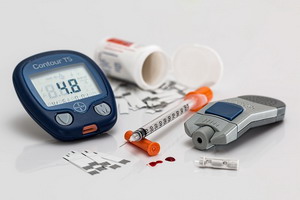 Welcome to the New Year! With the New Year comes the resolutions for improving your life in the coming year. Probably the most common resolution chosen in this country is weight loss. This is likely a reflection of the fact that 74% of Americans are overweight. Worse than that, 42% of adults over the age of 20 are clinically obese. The current projections are that over the next 6 years, those numbers will reach 86% overweight and 51% obese. These numbers are staggering. If we leave out the Pacific islanders, we are the second most obese nation in the world, beaten out only by Kuwait.
Welcome to the New Year! With the New Year comes the resolutions for improving your life in the coming year. Probably the most common resolution chosen in this country is weight loss. This is likely a reflection of the fact that 74% of Americans are overweight. Worse than that, 42% of adults over the age of 20 are clinically obese. The current projections are that over the next 6 years, those numbers will reach 86% overweight and 51% obese. These numbers are staggering. If we leave out the Pacific islanders, we are the second most obese nation in the world, beaten out only by Kuwait.
 Obesity is not a social perception problem, it is the obvious tip of the metabolic iceberg successfully sinking our ship of health. Metabolic syndrome, the underlying cause of obesity, is also the prime driver of the most common causes of chronic disease and early death. Health concerns that used to be reserved for those in their 70s and 80s are now commonly seen in folks in their 30s and 40s. Embracing obesity as the new normal means embracing chronic disease and early death as the new normal. I have been overweight since I was 8 years old, and have been on one diet or another since age 12. Back then I was the only fat kid in my school. If I were in grammar school now, I would have lots of friends that were fat like me. In my case, this health reality motivated me to become a health nut. It was a prime driver in my journey to become a doctor. I wanted to understand my body so I could make it healthy.
Obesity is not a social perception problem, it is the obvious tip of the metabolic iceberg successfully sinking our ship of health. Metabolic syndrome, the underlying cause of obesity, is also the prime driver of the most common causes of chronic disease and early death. Health concerns that used to be reserved for those in their 70s and 80s are now commonly seen in folks in their 30s and 40s. Embracing obesity as the new normal means embracing chronic disease and early death as the new normal. I have been overweight since I was 8 years old, and have been on one diet or another since age 12. Back then I was the only fat kid in my school. If I were in grammar school now, I would have lots of friends that were fat like me. In my case, this health reality motivated me to become a health nut. It was a prime driver in my journey to become a doctor. I wanted to understand my body so I could make it healthy.
 GLP 1 is the latest area of interest I have grabbed onto in my search to understand my metabolism. What is GLP 1? GLP 1 (glucagon-like peptide 1) is a hormone manufactured in the gut in response to certain foods. It tells your body that you have eaten and food is on its way. This hormone is then released into your blood and “talks” to dozens of areas in your body by attaching to special receptor docking ports on the outer membranes of these various tissues. The effect of this hormone is well understood on the pancreas, hypothalamus, and gut smooth muscle, but is not understood for lots of other tissues like the heart, lungs, and kidneys.
GLP 1 is the latest area of interest I have grabbed onto in my search to understand my metabolism. What is GLP 1? GLP 1 (glucagon-like peptide 1) is a hormone manufactured in the gut in response to certain foods. It tells your body that you have eaten and food is on its way. This hormone is then released into your blood and “talks” to dozens of areas in your body by attaching to special receptor docking ports on the outer membranes of these various tissues. The effect of this hormone is well understood on the pancreas, hypothalamus, and gut smooth muscle, but is not understood for lots of other tissues like the heart, lungs, and kidneys.
 GLP 1 has been big in the news lately because several drug companies have created fake versions of this hormone. Initially, it was created as a treatment for diabetes because one of the effects of this hormone (and its drug copy) is to signal the pancreas to dump out a bunch of insulin. So the idea is that if you are a diabetic, you could take this hormone instead of shots of insulin. Like insulin, this drug version of GLP 1 was taken in microgram doses injected every day. That has been around since 2005. The big news is that doses a thousand times higher have been approved by the FDA so that the drug could be injected only once a week. We are talking about Ozempic, Wegovy, and Mounjaro. These guys are big news lately as the miracle weight loss drugs all the celebrities are using. They do work, which is a first in the world of weight loss. But at what price?
GLP 1 has been big in the news lately because several drug companies have created fake versions of this hormone. Initially, it was created as a treatment for diabetes because one of the effects of this hormone (and its drug copy) is to signal the pancreas to dump out a bunch of insulin. So the idea is that if you are a diabetic, you could take this hormone instead of shots of insulin. Like insulin, this drug version of GLP 1 was taken in microgram doses injected every day. That has been around since 2005. The big news is that doses a thousand times higher have been approved by the FDA so that the drug could be injected only once a week. We are talking about Ozempic, Wegovy, and Mounjaro. These guys are big news lately as the miracle weight loss drugs all the celebrities are using. They do work, which is a first in the world of weight loss. But at what price?
 Let us consider the actual dollar price of Ozempic. The retail price is $935.77 per 1.5 ml injectable pen. We are talking about a weekly injection. So we are talking about $48,660 a year for the rest of your life. Several studies have already shown that patients regain 70 to 80% of their lost weight within a year of stopping the medication. Heads up, unless you are already a type 2 diabetic taking insulin, your insurance does not cover a penny of this cost. However, in many countries, there is an active black market for this drug so you may be able to get this for less with a few risks involved.
Let us consider the actual dollar price of Ozempic. The retail price is $935.77 per 1.5 ml injectable pen. We are talking about a weekly injection. So we are talking about $48,660 a year for the rest of your life. Several studies have already shown that patients regain 70 to 80% of their lost weight within a year of stopping the medication. Heads up, unless you are already a type 2 diabetic taking insulin, your insurance does not cover a penny of this cost. However, in many countries, there is an active black market for this drug so you may be able to get this for less with a few risks involved.
 Second, let’s consider the upfront side effects of taking these GLP 1 hormone replacements (also called GLP 1 receptor agonists.) Around 50% of patients report nausea. Diarrhea and reflux are also very common. Occasionally a bowel blockage occurs requiring surgery. The larger question is what are the long-term effects of these high-potency hormone replacements? There are zero studies on the long-term effects of this stuff. It is kind of like the high-dose fake female hormones used in the 70s for birth control. It took 20 years before they figured out that these were not a good idea after many women died of unnecessary cancers. We have no idea how this new hormone replacement will affect many areas of the body.
Second, let’s consider the upfront side effects of taking these GLP 1 hormone replacements (also called GLP 1 receptor agonists.) Around 50% of patients report nausea. Diarrhea and reflux are also very common. Occasionally a bowel blockage occurs requiring surgery. The larger question is what are the long-term effects of these high-potency hormone replacements? There are zero studies on the long-term effects of this stuff. It is kind of like the high-dose fake female hormones used in the 70s for birth control. It took 20 years before they figured out that these were not a good idea after many women died of unnecessary cancers. We have no idea how this new hormone replacement will affect many areas of the body.
 Despite living outside the box in my medical views on health, I am by nature very conservative. I like to wait quite a while before trying out any of these new wonder drugs. In my many years of experience, very few of them pan out in the long run. But what can we do if we want the benefits without taking the risks of being the guinea pig for some pharmaceutical company? The simple answer is to understand what naturally stimulates the production of this hormone the way it was intended. We have a system that has been onboard for millions of years and fine-tuned for that long. Then suddenly in the last 100 years, the fine-tuning has gone haywire. What are we doing that has messed the system up and how can we reset it?
Despite living outside the box in my medical views on health, I am by nature very conservative. I like to wait quite a while before trying out any of these new wonder drugs. In my many years of experience, very few of them pan out in the long run. But what can we do if we want the benefits without taking the risks of being the guinea pig for some pharmaceutical company? The simple answer is to understand what naturally stimulates the production of this hormone the way it was intended. We have a system that has been onboard for millions of years and fine-tuned for that long. Then suddenly in the last 100 years, the fine-tuning has gone haywire. What are we doing that has messed the system up and how can we reset it?
 Several of my previous articles have delved into how our modern diet and lifestyle have screwed up our natural metabolic processes. Four big points are the massive increase in sugar and vegetable oil consumption, the lack of daily constant movement, the massive load of hormone disruptors and toxic chemicals we are exposed to, and the constant levels of many kinds of chronic stress. All of these damage our ability to keep our metabolism balanced. GLP 1 is one of those balance systems in our body. It is supposed to give our system the heads-up to be prepared for what we are eating before it gets into the bloodstream. So what does it respond to? The receptors in the small intestine (g coupled receptors) that create the GLP 1 respond to simple sugars, amino acids and small peptides, short-chain fatty acids, longer-chain mono and polyunsaturated fats, and polyphenols. These receptors are also moderated by certain friendly gut bacteria. So if we want the benefits of something like Ozempic but want to go the natural route, we will use real foods. The effect will not be as powerful as the drug, but then we won’t have the side effects or the unknown long-term effects.
Several of my previous articles have delved into how our modern diet and lifestyle have screwed up our natural metabolic processes. Four big points are the massive increase in sugar and vegetable oil consumption, the lack of daily constant movement, the massive load of hormone disruptors and toxic chemicals we are exposed to, and the constant levels of many kinds of chronic stress. All of these damage our ability to keep our metabolism balanced. GLP 1 is one of those balance systems in our body. It is supposed to give our system the heads-up to be prepared for what we are eating before it gets into the bloodstream. So what does it respond to? The receptors in the small intestine (g coupled receptors) that create the GLP 1 respond to simple sugars, amino acids and small peptides, short-chain fatty acids, longer-chain mono and polyunsaturated fats, and polyphenols. These receptors are also moderated by certain friendly gut bacteria. So if we want the benefits of something like Ozempic but want to go the natural route, we will use real foods. The effect will not be as powerful as the drug, but then we won’t have the side effects or the unknown long-term effects.
Powerful GLP 1 stimulators:
At least 30% of your calories as digestible protein
Small peptide proteins like collagen
Digestible fibers that gut bacteria turn into short-chain fatty acids
Monosaturated oils like olive and avocado
MCT oil and omega 3 oils
Polyphenols like EGCG from green tea, quercetin, curcumin, etc.
3 especially powerful stimulators – berberine, allulose, and Akkermansia muciniphila probiotic
 What we want to avoid even though they do stimulate GLP 1 are the two substances that are creating the problems in the first place because of their massive overuse – sugar/carbs, and vegetable oils. These are not inherently bad, but their overuse has made them bad. Everything needs to be in a natural balance for our system to process it properly. We were not designed to process junk food and highly processed food. Even something as simple as peanut butter on toast is a problem. Fats and carbs do not appear in the same food in nature. They are designed to be eaten separately at different times, not together. Our cooking styles count as processing.
What we want to avoid even though they do stimulate GLP 1 are the two substances that are creating the problems in the first place because of their massive overuse – sugar/carbs, and vegetable oils. These are not inherently bad, but their overuse has made them bad. Everything needs to be in a natural balance for our system to process it properly. We were not designed to process junk food and highly processed food. Even something as simple as peanut butter on toast is a problem. Fats and carbs do not appear in the same food in nature. They are designed to be eaten separately at different times, not together. Our cooking styles count as processing.
 So starting the New Year with a resolution to lose weight does not need to be an exercise in frustration. To avoid failure, we have to understand the body much better than we ever have. Many different eating styles and philosophies can be used to successfully lose weight, but basic rules on how the body operates can not be ignored. Understanding how our gut hormones are designed to regulate our metabolism is just one of those pieces we need to become effective in supporting our health.
So starting the New Year with a resolution to lose weight does not need to be an exercise in frustration. To avoid failure, we have to understand the body much better than we ever have. Many different eating styles and philosophies can be used to successfully lose weight, but basic rules on how the body operates can not be ignored. Understanding how our gut hormones are designed to regulate our metabolism is just one of those pieces we need to become effective in supporting our health.
Take care,
David
 Now Available: Penetrating Relief DMSO liquid – $6
Now Available: Penetrating Relief DMSO liquid – $6
Ellen
 Christmas morning! Christmas was pretty quiet for Ellen and I. We opened a couple gifts and then I took a Christmas brunch up to my mom in Colfax. We did make it out to a movie Christmas eve. The big event was a special treat Ellen had been wanting for a long time – Key Lime Pie! Even though we avoid sugar most of the year, during the holidays we do indulge for a week or so. By the time you get this it will be 2024, so Happy New year!
Christmas morning! Christmas was pretty quiet for Ellen and I. We opened a couple gifts and then I took a Christmas brunch up to my mom in Colfax. We did make it out to a movie Christmas eve. The big event was a special treat Ellen had been wanting for a long time – Key Lime Pie! Even though we avoid sugar most of the year, during the holidays we do indulge for a week or so. By the time you get this it will be 2024, so Happy New year!
 Yogurt reduces anxiety/stressIt has been discovered that the gut bacteria lactobacillus, found in yogurt and other fermented foods, in some way reduces the production of an inflammatory cytokine called interferon gamma. This cytokine increases our fear and anxiety response. Thus having plenty lactobacillus in our gut helps our mood.
Yogurt reduces anxiety/stressIt has been discovered that the gut bacteria lactobacillus, found in yogurt and other fermented foods, in some way reduces the production of an inflammatory cytokine called interferon gamma. This cytokine increases our fear and anxiety response. Thus having plenty lactobacillus in our gut helps our mood.
 Pets slow cognitive declineAlmost 30% of people live alone, and this is a significant promoter of cognitive decline. Along running study in England started looking at pet ownership as part of their data and found that having a pet just about eliminated the impact of living alone on mental decline. I would think that having someone to love gives you reason to stay connected to the planet.
Pets slow cognitive declineAlmost 30% of people live alone, and this is a significant promoter of cognitive decline. Along running study in England started looking at pet ownership as part of their data and found that having a pet just about eliminated the impact of living alone on mental decline. I would think that having someone to love gives you reason to stay connected to the planet.
 Dahlias stabilize blood sugarAn extract of Dahlia petals has been found to stabilize blood sugar levels in diabetic and prediabetic patients. Dahlia is found to impact the blood sugar regulation part of the brain that has become inflamed.
Dahlias stabilize blood sugarAn extract of Dahlia petals has been found to stabilize blood sugar levels in diabetic and prediabetic patients. Dahlia is found to impact the blood sugar regulation part of the brain that has become inflamed.

 Welcome to the New Year! With the New Year comes the resolutions for improving your life in the coming year. Probably the most common resolution chosen in this country is weight loss. This is likely a reflection of the fact that 74% of Americans are overweight. Worse than that, 42% of adults over the age of 20 are clinically obese. The current projections are that over the next 6 years, those numbers will reach 86% overweight and 51% obese. These numbers are staggering. If we leave out the Pacific islanders, we are the second most obese nation in the world, beaten out only by Kuwait.
Welcome to the New Year! With the New Year comes the resolutions for improving your life in the coming year. Probably the most common resolution chosen in this country is weight loss. This is likely a reflection of the fact that 74% of Americans are overweight. Worse than that, 42% of adults over the age of 20 are clinically obese. The current projections are that over the next 6 years, those numbers will reach 86% overweight and 51% obese. These numbers are staggering. If we leave out the Pacific islanders, we are the second most obese nation in the world, beaten out only by Kuwait. Obesity is not a social perception problem, it is the obvious tip of the metabolic iceberg successfully sinking our ship of health. Metabolic syndrome, the underlying cause of obesity, is also the prime driver of the most common causes of chronic disease and early death. Health concerns that used to be reserved for those in their 70s and 80s are now commonly seen in folks in their 30s and 40s. Embracing obesity as the new normal means embracing chronic disease and early death as the new normal. I have been overweight since I was 8 years old, and have been on one diet or another since age 12. Back then I was the only fat kid in my school. If I were in grammar school now, I would have lots of friends that were fat like me. In my case, this health reality motivated me to become a health nut. It was a prime driver in my journey to become a doctor. I wanted to understand my body so I could make it healthy.
Obesity is not a social perception problem, it is the obvious tip of the metabolic iceberg successfully sinking our ship of health. Metabolic syndrome, the underlying cause of obesity, is also the prime driver of the most common causes of chronic disease and early death. Health concerns that used to be reserved for those in their 70s and 80s are now commonly seen in folks in their 30s and 40s. Embracing obesity as the new normal means embracing chronic disease and early death as the new normal. I have been overweight since I was 8 years old, and have been on one diet or another since age 12. Back then I was the only fat kid in my school. If I were in grammar school now, I would have lots of friends that were fat like me. In my case, this health reality motivated me to become a health nut. It was a prime driver in my journey to become a doctor. I wanted to understand my body so I could make it healthy. GLP 1 is the latest area of interest I have grabbed onto in my search to understand my metabolism. What is GLP 1? GLP 1 (glucagon-like peptide 1) is a hormone manufactured in the gut in response to certain foods. It tells your body that you have eaten and food is on its way. This hormone is then released into your blood and “talks” to dozens of areas in your body by attaching to special receptor docking ports on the outer membranes of these various tissues. The effect of this hormone is well understood on the pancreas, hypothalamus, and gut smooth muscle, but is not understood for lots of other tissues like the heart, lungs, and kidneys.
GLP 1 is the latest area of interest I have grabbed onto in my search to understand my metabolism. What is GLP 1? GLP 1 (glucagon-like peptide 1) is a hormone manufactured in the gut in response to certain foods. It tells your body that you have eaten and food is on its way. This hormone is then released into your blood and “talks” to dozens of areas in your body by attaching to special receptor docking ports on the outer membranes of these various tissues. The effect of this hormone is well understood on the pancreas, hypothalamus, and gut smooth muscle, but is not understood for lots of other tissues like the heart, lungs, and kidneys. GLP 1 has been big in the news lately because several drug companies have created fake versions of this hormone. Initially, it was created as a treatment for diabetes because one of the effects of this hormone (and its drug copy) is to signal the pancreas to dump out a bunch of insulin. So the idea is that if you are a diabetic, you could take this hormone instead of shots of insulin. Like insulin, this drug version of GLP 1 was taken in microgram doses injected every day. That has been around since 2005. The big news is that doses a thousand times higher have been approved by the FDA so that the drug could be injected only once a week. We are talking about Ozempic, Wegovy, and Mounjaro. These guys are big news lately as the miracle weight loss drugs all the celebrities are using. They do work, which is a first in the world of weight loss. But at what price?
GLP 1 has been big in the news lately because several drug companies have created fake versions of this hormone. Initially, it was created as a treatment for diabetes because one of the effects of this hormone (and its drug copy) is to signal the pancreas to dump out a bunch of insulin. So the idea is that if you are a diabetic, you could take this hormone instead of shots of insulin. Like insulin, this drug version of GLP 1 was taken in microgram doses injected every day. That has been around since 2005. The big news is that doses a thousand times higher have been approved by the FDA so that the drug could be injected only once a week. We are talking about Ozempic, Wegovy, and Mounjaro. These guys are big news lately as the miracle weight loss drugs all the celebrities are using. They do work, which is a first in the world of weight loss. But at what price? Let us consider the actual dollar price of Ozempic. The retail price is $935.77 per 1.5 ml injectable pen. We are talking about a weekly injection. So we are talking about $48,660 a year for the rest of your life. Several studies have already shown that patients regain 70 to 80% of their lost weight within a year of stopping the medication. Heads up, unless you are already a type 2 diabetic taking insulin, your insurance does not cover a penny of this cost. However, in many countries, there is an active black market for this drug so you may be able to get this for less with a few risks involved.
Let us consider the actual dollar price of Ozempic. The retail price is $935.77 per 1.5 ml injectable pen. We are talking about a weekly injection. So we are talking about $48,660 a year for the rest of your life. Several studies have already shown that patients regain 70 to 80% of their lost weight within a year of stopping the medication. Heads up, unless you are already a type 2 diabetic taking insulin, your insurance does not cover a penny of this cost. However, in many countries, there is an active black market for this drug so you may be able to get this for less with a few risks involved. Second, let’s consider the upfront side effects of taking these GLP 1 hormone replacements (also called GLP 1 receptor agonists.) Around 50% of patients report nausea. Diarrhea and reflux are also very common. Occasionally a bowel blockage occurs requiring surgery. The larger question is what are the long-term effects of these high-potency hormone replacements? There are zero studies on the long-term effects of this stuff. It is kind of like the high-dose fake female hormones used in the 70s for birth control. It took 20 years before they figured out that these were not a good idea after many women died of unnecessary cancers. We have no idea how this new hormone replacement will affect many areas of the body.
Second, let’s consider the upfront side effects of taking these GLP 1 hormone replacements (also called GLP 1 receptor agonists.) Around 50% of patients report nausea. Diarrhea and reflux are also very common. Occasionally a bowel blockage occurs requiring surgery. The larger question is what are the long-term effects of these high-potency hormone replacements? There are zero studies on the long-term effects of this stuff. It is kind of like the high-dose fake female hormones used in the 70s for birth control. It took 20 years before they figured out that these were not a good idea after many women died of unnecessary cancers. We have no idea how this new hormone replacement will affect many areas of the body. Despite living outside the box in my medical views on health, I am by nature very conservative. I like to wait quite a while before trying out any of these new wonder drugs. In my many years of experience, very few of them pan out in the long run. But what can we do if we want the benefits without taking the risks of being the guinea pig for some pharmaceutical company? The simple answer is to understand what naturally stimulates the production of this hormone the way it was intended. We have a system that has been onboard for millions of years and fine-tuned for that long. Then suddenly in the last 100 years, the fine-tuning has gone haywire. What are we doing that has messed the system up and how can we reset it?
Despite living outside the box in my medical views on health, I am by nature very conservative. I like to wait quite a while before trying out any of these new wonder drugs. In my many years of experience, very few of them pan out in the long run. But what can we do if we want the benefits without taking the risks of being the guinea pig for some pharmaceutical company? The simple answer is to understand what naturally stimulates the production of this hormone the way it was intended. We have a system that has been onboard for millions of years and fine-tuned for that long. Then suddenly in the last 100 years, the fine-tuning has gone haywire. What are we doing that has messed the system up and how can we reset it? Several of my previous articles have delved into how our modern diet and lifestyle have screwed up our natural metabolic processes. Four big points are the massive increase in sugar and vegetable oil consumption, the lack of daily constant movement, the massive load of hormone disruptors and toxic chemicals we are exposed to, and the constant levels of many kinds of chronic stress. All of these damage our ability to keep our metabolism balanced. GLP 1 is one of those balance systems in our body. It is supposed to give our system the heads-up to be prepared for what we are eating before it gets into the bloodstream. So what does it respond to? The receptors in the small intestine (g coupled receptors) that create the GLP 1 respond to simple sugars, amino acids and small peptides, short-chain fatty acids, longer-chain mono and polyunsaturated fats, and polyphenols. These receptors are also moderated by certain friendly gut bacteria. So if we want the benefits of something like Ozempic but want to go the natural route, we will use real foods. The effect will not be as powerful as the drug, but then we won’t have the side effects or the unknown long-term effects.
Several of my previous articles have delved into how our modern diet and lifestyle have screwed up our natural metabolic processes. Four big points are the massive increase in sugar and vegetable oil consumption, the lack of daily constant movement, the massive load of hormone disruptors and toxic chemicals we are exposed to, and the constant levels of many kinds of chronic stress. All of these damage our ability to keep our metabolism balanced. GLP 1 is one of those balance systems in our body. It is supposed to give our system the heads-up to be prepared for what we are eating before it gets into the bloodstream. So what does it respond to? The receptors in the small intestine (g coupled receptors) that create the GLP 1 respond to simple sugars, amino acids and small peptides, short-chain fatty acids, longer-chain mono and polyunsaturated fats, and polyphenols. These receptors are also moderated by certain friendly gut bacteria. So if we want the benefits of something like Ozempic but want to go the natural route, we will use real foods. The effect will not be as powerful as the drug, but then we won’t have the side effects or the unknown long-term effects. What we want to avoid even though they do stimulate GLP 1 are the two substances that are creating the problems in the first place because of their massive overuse – sugar/carbs, and vegetable oils. These are not inherently bad, but their overuse has made them bad. Everything needs to be in a natural balance for our system to process it properly. We were not designed to process junk food and highly processed food. Even something as simple as peanut butter on toast is a problem. Fats and carbs do not appear in the same food in nature. They are designed to be eaten separately at different times, not together. Our cooking styles count as processing.
What we want to avoid even though they do stimulate GLP 1 are the two substances that are creating the problems in the first place because of their massive overuse – sugar/carbs, and vegetable oils. These are not inherently bad, but their overuse has made them bad. Everything needs to be in a natural balance for our system to process it properly. We were not designed to process junk food and highly processed food. Even something as simple as peanut butter on toast is a problem. Fats and carbs do not appear in the same food in nature. They are designed to be eaten separately at different times, not together. Our cooking styles count as processing. So starting the New Year with a resolution to lose weight does not need to be an exercise in frustration. To avoid failure, we have to understand the body much better than we ever have. Many different eating styles and philosophies can be used to successfully lose weight, but basic rules on how the body operates can not be ignored. Understanding how our gut hormones are designed to regulate our metabolism is just one of those pieces we need to become effective in supporting our health.
So starting the New Year with a resolution to lose weight does not need to be an exercise in frustration. To avoid failure, we have to understand the body much better than we ever have. Many different eating styles and philosophies can be used to successfully lose weight, but basic rules on how the body operates can not be ignored. Understanding how our gut hormones are designed to regulate our metabolism is just one of those pieces we need to become effective in supporting our health. Now Available: Penetrating Relief DMSO liquid – $6
Now Available: Penetrating Relief DMSO liquid – $6 Christmas morning! Christmas was pretty quiet for Ellen and I. We opened a couple gifts and then I took a Christmas brunch up to my mom in Colfax. We did make it out to a movie Christmas eve. The big event was a special treat Ellen had been wanting for a long time – Key Lime Pie! Even though we avoid sugar most of the year, during the holidays we do indulge for a week or so. By the time you get this it will be 2024, so Happy New year!
Christmas morning! Christmas was pretty quiet for Ellen and I. We opened a couple gifts and then I took a Christmas brunch up to my mom in Colfax. We did make it out to a movie Christmas eve. The big event was a special treat Ellen had been wanting for a long time – Key Lime Pie! Even though we avoid sugar most of the year, during the holidays we do indulge for a week or so. By the time you get this it will be 2024, so Happy New year!